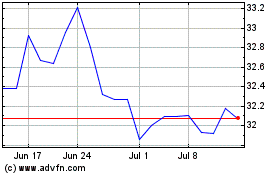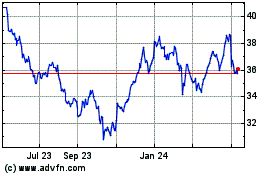By Annie Gasparro
America's packaged-food giants are losing the battle for
retailers' shelf space, complicating their efforts to break out of
a yearslong slump.
Instead of promoting canned soup, cereal and cookies from
companies like Kraft Heinz Co., Kellogg Co. and Mondelez
International Inc., grocery stores are choosing to give better play
to fresh food, prepared hot meals, and items from local upstarts
more in favor with increasingly health-conscious consumers.
"We've got to maximize return on our shelf space," said Don
Fitzgerald, vice president of merchandising at Mariano's, a Chicago
grocery chain bought by Kroger Co. in 2015. Shoppers, he said, are
drawn to steamy pasta at the store's deli counter, rather than a
box of dried macaroni with powdered cheese sitting on the shelf for
weeks.
New Jersey-based ShopRite and other grocery-store chains around
the country are building new stores that have less space for
traditional packaged foods in the center aisles and more for
in-store restaurants and fresh meals shoppers can take home. "It's
by demand of consumers looking for a quick meal," said Natalie
Menza, ShopRite's director of health and wellness.
CVS Health Corp.'s drugstore chain recently said it planned to
upgrade hundreds of its stores to focus more on healthier
products.
That means less space for traditional packaged-food brands,
which are also facing increased competition from store brands and
smaller upstarts.
Sales volume for packaged food and products -- reflecting the
number of items sold -- fell 2.4% in the first quarter of 2017,
according to market-research firm Nielsen. In in the year ended
Feb. 25, sales volume for packaged food and beverages shrank by
0.4% -- compared with growth of 1.7% for fresh meat, 1.9% for
produce and 4% for deli-prepared foods during that period, Nielsen
said.
Three of the biggest companies in the sector -- Mondelez, Kraft
Heinz and Kellogg -- are expected to show the impact of these
trends when they report first-quarter results this week. RBC
Capital Markets' David Palmer recently lowered his forecast for the
three, saying in a note to investors that "big food volume trends
have not yet begun to recover after six months of accelerating
declines."
Teresa Benande, a 70-year-old shopping in a Chicago Mariano's
grocery store, said she recently nixed chips and cereal, and now
she usually buys chicken breasts, brown rice, potatoes, and fresh
vegetables and fruit.
"I stopped buying that stuff because it has too much salt and
sugar. Even the boxes that appear healthy, when you read them, they
really aren't," she said. When she splurges, it is on a spinach and
feta pizza, not a bag of Doritos, she said.
The shift in shopper preferences started several years ago, but
its impact on big food makers is intensifying now because of added
pressure from retailers.
That has exacerbated what has been a drumbeat of bad news for
packaged-goods companies grappling with American consumers'
sustained move toward natural, organic foods. A long stretch of
falling food prices, fueled by excess supplies of staples like meat
and dairy, have also lowered costs for consumers at supermarkets,
giving them more reason to choose fresh food over boxed meals.
Plus, more people are buying cheaper store brands and shopping
for unique health-focused brands online.
"It's death by a thousand cuts," said Nielsen consumer analyst
Jordan Rost.
Mondelez, which makes Oreo cookies and Ritz crackers, initially
expected its comparable sales to rise at least 1% this year, but
that could decline if its sales results for the first quarter are
worse than anticipated -- as was the case with Hershey Co., which
reported last week.
Big companies such as Unilever PLC and Nestlé SA said in April
that North America food sales are underperforming as customers
avoid the center aisles of grocery stores.
Mark Clouse, Chief Executive of Pinnacle Foods Inc., which sells
Duncan Hines cake mixes and Vlassic pickles, said no one factor
alone was driving the industry's woes, and he was optimistic about
early sales figures from April. "But I think it will be a tough
environment" this year, he said.
Mariano's Mr. Fitzgerald said his stores, like other retailers,
aren't giving up on big brands. But finding new ways to entice
people to walk through the center aisles again is tricky.
Some brands are seeking ways to get their products into the
fresh and prepared foods section of the store. But, Mr. Fitzgerald
says: "If we overrun perishables with all the big packaged brands,
we lose our competitive edge."
Instead, retailers such as Wal-Mart Stores Inc. are pressuring
big brands to lower their prices as a way to attract customers.
Companies like Hershey and PepsiCo Inc. said they are working
with retailers to be creative. "That's a conversation we've been
having with some of the retailers, to say 'how can we help you
rethink the center store so that we can bring growth back," said
Pepsi Chief Indra Nooyi on a conference call last week, when it
reported declines in its Quaker Foods division. "Our hope is that
with the rejuvenation of the center store, our categories will
grow, too."
Big brands are increasingly focusing on improving profitability
through cost-cutting and consolidation.
Kraft and Heinz combined two years ago as slow growth spurred a
need for savings. Kraft Heinz Co. has been able to cut more than $1
billion from the two predecessor companies' budgets. Earlier this
year, it made an unsolicited $143 billion offer for Unilever -- the
Anglo-Dutch maker of Dove soap and Hellmann's mayonnaise -- which
was rebuffed.
Some analysts say Kraft Heinz's sights could be set on Mondelez,
which unsuccessfully attempted to buy Hershey last year. They argue
that such an union would benefit both companies and make them
better equipped to deal with the new reality of slowing sales and
heightened competition.
Both companies have declined to comment on a potential deal.
Kraft and Mondelez used to be part of the same conglomerate until
2012, when it was split in two.
(END) Dow Jones Newswires
April 30, 2017 20:15 ET (00:15 GMT)
Copyright (c) 2017 Dow Jones & Company, Inc.
Kraft Heinz (NASDAQ:KHC)
Historical Stock Chart
From Mar 2024 to Apr 2024

Kraft Heinz (NASDAQ:KHC)
Historical Stock Chart
From Apr 2023 to Apr 2024
